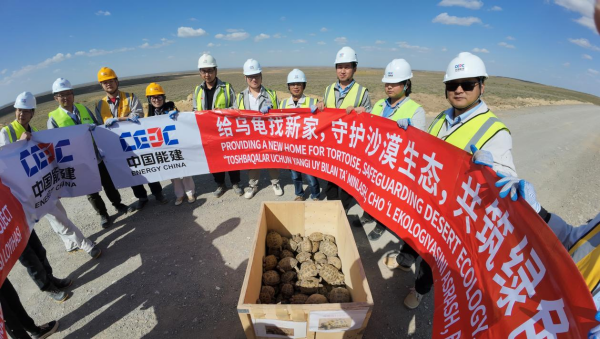In the heart of the Kyzylkum Desert in Uzbekistan, 158 towering wind turbines sweep across the golden sands, delivering a powerful message of green development and China-Central Asia cooperation under the Belt and Road Initiative.
Led by China Energy Engineering Group Co., Ltd (Energy China), the Bukhara Wind Power Project is a flagship effort to turn harsh desert conditions into an opportunity for sustainable progress.
From desert hardship to ecological innovation
Situated in the heart of a scorching, arid desert, the project site is plagued by extreme temperatures, water shortages, and barren soil — conditions that severely test the limits of construction. Supplying fresh vegetables for over 1,000 workers was costly and difficult. Meanwhile, wastewater treatment alone cost 200 million Uzbekistani soms per month, placing a heavy burden on environmental responsibilities.

A view of the Bukhara Wind Power Project [Photo/sasac.gov.cn]
To address these issues, the project team created an eco-friendly “vegetable garden” using treated wastewater and drip irrigation. Organic fertilizer improved the sandy soil, and Chinese vegetables like amaranth and crown daisy flourished. The garden now supplies fresh produce year-round and saves over 1 million yuan in annual food costs. More importantly, this sustainable model offers a replicable solution for ecological restoration in arid Central Asia.
Technical breakthroughs amid harsh climate
Central Asia’s extreme temperatures pushed the engineering team to innovate. Surface temperatures can reach 50°C in summer and drop to -30°C in winter, making concrete pouring a major challenge. Bash Wind Farm project manager Wang Chenle’s team used ice machines to cool concrete in summer and tested 37 winter formulas to prevent cracking.
During turbine installation, the team streamlined crane movement. What once took three days was reduced to just eight hours using a modular “half-disassembly + lateral move” approach, boosting efficiency by 30 percent and decreasing equipment wear by 40 percent.
Young talents shine on the global stage
At the control room in the early hours, 26-year-old engineer Guo Jinqun was fine-tuning system code with a U.S. partner. As the first Chinese project to adopt the Eagle Eye monitoring system, the Bukhara wind farm faced unexpected compatibility challenges that threatened to delay progress. Guo proposed a time zone compensation solution that resolved the issue efficiently, earning recognition from foreign engineers.
Other young engineers also made their mark. Site manager Wang Run at the Dzhankeldy Wind Farm overcame ultra-hard rock using a new “silent blast + hydraulic split” method, improving excavation efficiency fivefold. HSE assistant Wu Taotao meticulously addressed 187 safety issues to meet European standards and helped build a 40-km barrier to protect the endangered Central Asian tortoise.

Project team protect the endangered Central Asian tortoise [Photo/sasac.gov.cn]
Building bridges of understanding
Beyond technology, people-to-people ties are growing. On traditional Chinese festivals, Chinese and Uzbek workers gather to make zongzi together. At the nearby Ayakagytma village, the project team built a football field and a science popularization classroom, inspiring local children to draw wind turbines in their notebooks.
Now, spinning day and night, the turbines in Bukhara supply 3.59 billion kWh of green electricity annually, cutting carbon emissions by 1.6 million tons. More than a clean energy plant, the project represents technical innovation, youthful dedication, and cultural friendship.
(Executive editor: Cui Feng)